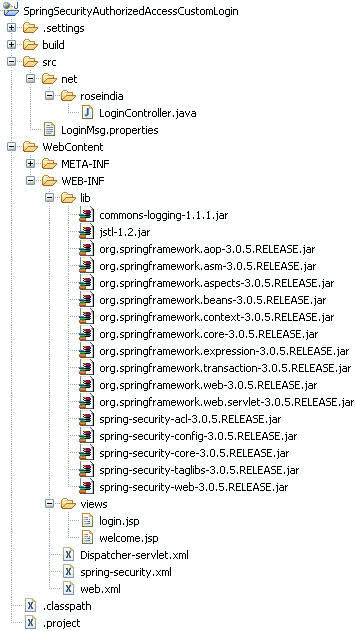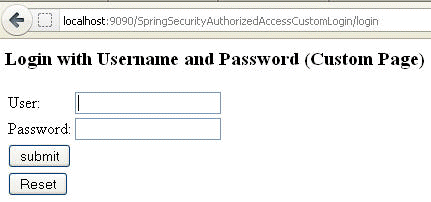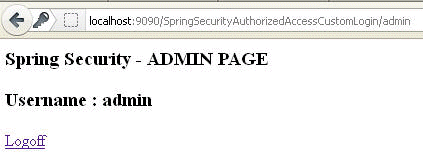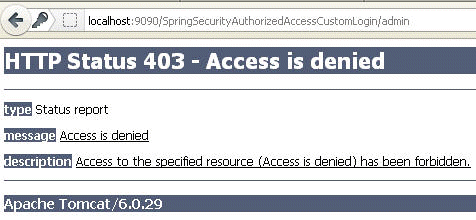Spring Security Authorized Access Using Custom Login Form
In this section, you will learn about authorized access using custom login form in Spring Security.
In this section, you will learn about authorized access using custom login form in Spring Security.Spring Security Authorized Access Using Custom Login Form
In this section, you will learn about authorized access using custom login form in Spring Security.
Sometimes you need to secure your page from unauthorized access. Authorized access is the secure access of page through a permitted username and password. For example, the admin section page can only have permission for admin only.
EXAMPLE
In the below example, we will ensure secure and authorized URL access by providing customized Login form using Spring Security. User needs to provide correct login credential to view the page. For accessing admin section, you need to provide admin login and password. While for user section, both admin and user login are permitted.
For Spring Security authorized access using auto generated login form. Click Here.
The tools and technologies used in the below example is given below :
- jdk1.6.0_18
- apache-tomcat-6.0.29
- Eclipse 3.5.1
- Spring 3.0.5.RELEASE
- Spring Security 3.0.5.RELEASE
You can implement user authentication using customized login(in spring-security.xml ) as follows :
<http auto-config="true"> <intercept-url pattern="/admin*" access="ROLE_ADMIN" /> <intercept-url pattern="/index*" access="ROLE_USER,ROLE_ADMIN" /> <form-login login-page="/login" authentication-failure-url="/failLogin" /> <logout logout-success-url="/logoff" /> </http>
It means the user with authority as ROLE_ADMIN can have access to URL /admin . Also, the URL /index is open for both type of users having authority ROLE_USER or ROLE_ADMIN .
The project structure and jar file used is given below :

CODE
web.xml
<?xml version="1.0" encoding="UTF-8"?> <web-app xmlns:xsi="http://www.w3.org/2001/XMLSchema-instance" xmlns="http://java.sun.com/xml/ns/javaee" xmlns:web="http://java.sun.com/xml/ns/javaee/web-app_2_5.xsd" xsi:schemaLocation="http://java.sun.com/xml/ns/javaee http://java.sun.com/xml/ns/javaee/web-app_2_5.xsd" id="WebApp_ID" version="2.5"> <display-name>SpringSecurityAuthorizedAccessCustomLogin</display-name> <servlet> <servlet-name>Dispatcher</servlet-name> <servlet-class>org.springframework.web.servlet.DispatcherServlet</servlet-class> <load-on-startup>1</load-on-startup> </servlet> <servlet-mapping> <servlet-name>Dispatcher</servlet-name> <url-pattern>/</url-pattern> </servlet-mapping> <listener> <listener-class>org.springframework.web.context.ContextLoaderListener</listener-class> </listener> <context-param> <param-name>contextConfigLocation</param-name> <param-value> /WEB-INF/Dispatcher-servlet.xml, /WEB-INF/spring-security.xml </param-value> </context-param> <filter> <filter-name>springSecurityFilterChain</filter-name> <filter-class>org.springframework.web.filter.DelegatingFilterProxy</filter-class> </filter> <filter-mapping> <filter-name>springSecurityFilterChain</filter-name> <url-pattern>/*</url-pattern> </filter-mapping> </web-app>
spring-security.xml
<?xml version="1.0" encoding="UTF-8"?> <beans:beans xmlns="http://www.springframework.org/schema/security" xmlns:beans="http://www.springframework.org/schema/beans" xmlns:xsi="http://www.w3.org/2001/XMLSchema-instance" xsi:schemaLocation="http://www.springframework.org/schema/beans http://www.springframework.org/schema/beans/spring-beans-3.0.xsd http://www.springframework.org/schema/security http://www.springframework.org/schema/security/spring-security-3.0.3.xsd"> <http auto-config="true"> <intercept-url pattern="/admin*" access="ROLE_ADMIN" /> <intercept-url pattern="/index*" access="ROLE_USER,ROLE_ADMIN" /> <form-login login-page="/login" default-target-url="/index" authentication-failure-url="/failLogin" /> <logout logout-success-url="/logoff" /> </http> <authentication-manager> <authentication-provider> <user-service> <user name="user" password="roseindia" authorities="ROLE_USER"/> <user name="admin" password="deepak" authorities="ROLE_ADMIN" /> </user-service> </authentication-provider> </authentication-manager> </beans:beans>
Dispatcher-servlet.xml
<beans xmlns="http://www.springframework.org/schema/beans" xmlns:context="http://www.springframework.org/schema/context" xmlns:xsi="http://www.w3.org/2001/XMLSchema-instance" xsi:schemaLocation=" http://www.springframework.org/schema/beans http://www.springframework.org/schema/beans/spring-beans-3.0.xsd http://www.springframework.org/schema/context http://www.springframework.org/schema/context/spring-context-3.0.xsd"> <context:component-scan base-package="net.roseindia" /> <bean class="org.springframework.web.servlet.view.InternalResourceViewResolver"> <property name="prefix"> <value>/WEB-INF/views/</value> </property> <property name="suffix"> <value>.jsp</value> </property> </bean> <bean id="messageSource" class="org.springframework.context.support.ResourceBundleMessageSource"> <property name="basenames"> <list> <value>LoginMsg</value> </list> </property> </bean> </beans>
LoginController.java
package net.roseindia;
import java.security.Principal;
import org.springframework.stereotype.Controller;
import org.springframework.ui.ModelMap;
import org.springframework.web.bind.annotation.RequestMapping;
import org.springframework.web.bind.annotation.RequestMethod;
@Controller
public class LoginController {
@RequestMapping(value = "/admin", method = RequestMethod.GET)
public String welcomeAdmin(ModelMap model, Principal principal) {
String username = principal.getName();
model.addAttribute("user", username);
model.addAttribute("msg", "Spring Security - ADMIN PAGE");
return "welcome";
}
@RequestMapping(value = "/index", method = RequestMethod.GET)
public String printMessage(ModelMap model, Principal principal) {
String username = principal.getName();
model.addAttribute("user", username);
model.addAttribute("msg", "Spring Security Custom Login Form");
return "welcome";
}
@RequestMapping(value = "/login", method = RequestMethod.GET)
public String login(ModelMap model) {
return "login";
}
@RequestMapping(value = "/failLogin", method = RequestMethod.GET)
public String failedLogin(ModelMap model) {
model.addAttribute("error", "true");
return "login";
}
@RequestMapping(value = "/logoff", method = RequestMethod.GET)
public String logoff(ModelMap model) {
return "login";
}
}
LoginMsg.properties
AbstractUserDetailsAuthenticationProvider.badCredentials=Wrong username\ /\ password
login.jsp
<%@ taglib prefix="c" uri="http://java.sun.com/jsp/jstl/core"%>
<html>
<head>
<title>Login Page</title>
<style>
.errorblock {
color: #ff0000;
background-color: #ffEEEE;
border: 3px solid #ff0000;
padding: 8px;
margin: 16px;
}
</style>
</head>
<body onload='document.f.j_username.focus();'>
<h3>Login with Username and Password (Custom Page)</h3>
<c:if test="${not empty error}">
<div class="errorblock">
Login error : Please try again.<br />Root Cause:
${sessionScope["SPRING_SECURITY_LAST_EXCEPTION"].message}
</div>
</c:if>
<form name='f' action="<c:url value='j_spring_security_check' />"
method='POST'>
<table>
<tr>
<td>User:</td>
<td><input type='text' name='j_username' value=''>
</td>
</tr>
<tr>
<td>Password:</td>
<td><input type='password' name='j_password' />
</td>
</tr>
<tr>
<td colspan='2'><input name="submit" type="submit"
value="submit" />
</td>
</tr>
<tr>
<td colspan='2'><input name="reset" type="reset" />
</td>
</tr>
</table>
</form>
</body>
</html>
welcome.jsp
<%@ taglib prefix="c" uri="http://java.sun.com/jsp/jstl/core"%>
<html>
<body>
<h3>${msg}</h3>
<h3>Username : ${user}</h3>
<a href="<c:url value="/j_spring_security_logout" />" > Logoff</a>
</body>
</html>
OUTPUT
When you try to access the below URL :
http://localhost:9090/SpringSecurityAuthorizedAccessCustomLogin/admin
You will get the following page(admin login) :

If you provide correct login(username: admin , password: deepak), you will get the following page :

If you try to login with a user login credential (username: user, password : roseindia), you will get the following error page :
